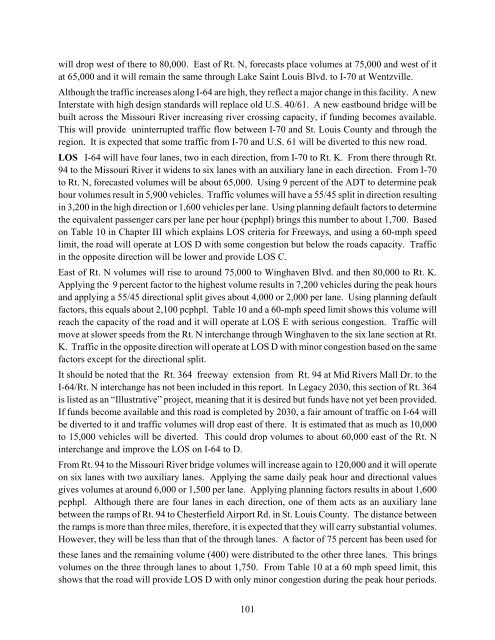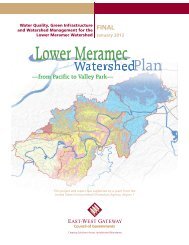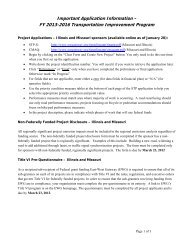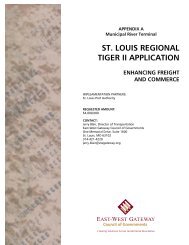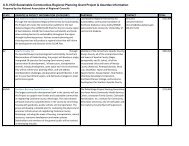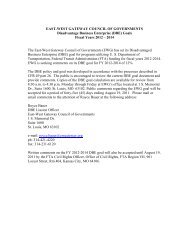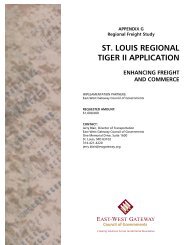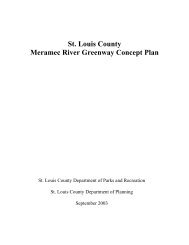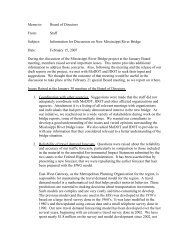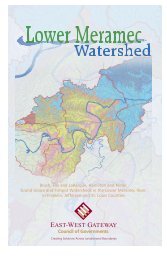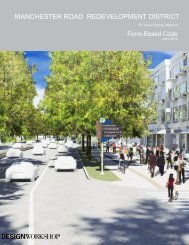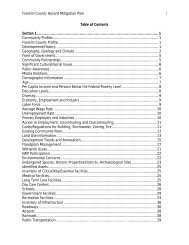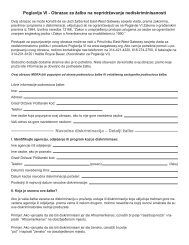St. Charles County Transportation Plan 2030 - East-West Gateway ...
St. Charles County Transportation Plan 2030 - East-West Gateway ...
St. Charles County Transportation Plan 2030 - East-West Gateway ...
Create successful ePaper yourself
Turn your PDF publications into a flip-book with our unique Google optimized e-Paper software.
will drop west of there to 80,000. <strong>East</strong> of Rt. N, forecasts place volumes at 75,000 and west of it<br />
at 65,000 and it will remain the same through Lake Saint Louis Blvd. to I-70 at Wentzville.<br />
Although the traffic increases along I-64 are high, they reflect a major change in this facility. A new<br />
Interstate with high design standards will replace old U.S. 40/61. A new eastbound bridge will be<br />
built across the Missouri River increasing river crossing capacity, if funding becomes available.<br />
This will provide uninterrupted traffic flow between I-70 and <strong>St</strong>. Louis <strong>County</strong> and through the<br />
region. It is expected that some traffic from I-70 and U.S. 61 will be diverted to this new road.<br />
LOS I-64 will have four lanes, two in each direction, from I-70 to Rt. K. From there through Rt.<br />
94 to the Missouri River it widens to six lanes with an auxiliary lane in each direction. From I-70<br />
to Rt. N, forecasted volumes will be about 65,000. Using 9 percent of the ADT to determine peak<br />
hour volumes result in 5,900 vehicles. Traffic volumes will have a 55/45 split in direction resulting<br />
in 3,200 in the high direction or 1,600 vehicles per lane. Using planning default factors to determine<br />
the equivalent passenger cars per lane per hour (pcphpl) brings this number to about 1,700. Based<br />
on Table 10 in Chapter III which explains LOS criteria for Freeways, and using a 60-mph speed<br />
limit, the road will operate at LOS D with some congestion but below the roads capacity. Traffic<br />
in the opposite direction will be lower and provide LOS C.<br />
<strong>East</strong> of Rt. N volumes will rise to around 75,000 to Winghaven Blvd. and then 80,000 to Rt. K.<br />
Applying the 9 percent factor to the highest volume results in 7,200 vehicles during the peak hours<br />
and applying a 55/45 directional split gives about 4,000 or 2,000 per lane. Using planning default<br />
factors, this equals about 2,100 pcphpl. Table 10 and a 60-mph speed limit shows this volume will<br />
reach the capacity of the road and it will operate at LOS E with serious congestion. Traffic will<br />
move at slower speeds from the Rt. N interchange through Winghaven to the six lane section at Rt.<br />
K. Traffic in the opposite direction will operate at LOS D with minor congestion based on the same<br />
factors except for the directional split.<br />
It should be noted that the Rt. 364 freeway extension from Rt. 94 at Mid Rivers Mall Dr. to the<br />
I-64/Rt. N interchange has not been included in this report. In Legacy <strong>2030</strong>, this section of Rt. 364<br />
is listed as an “Illustrative” project, meaning that it is desired but funds have not yet been provided.<br />
If funds become available and this road is completed by <strong>2030</strong>, a fair amount of traffic on I-64 will<br />
be diverted to it and traffic volumes will drop east of there. It is estimated that as much as 10,000<br />
to 15,000 vehicles will be diverted. This could drop volumes to about 60,000 east of the Rt. N<br />
interchange and improve the LOS on I-64 to D.<br />
From Rt. 94 to the Missouri River bridge volumes will increase again to 120,000 and it will operate<br />
on six lanes with two auxiliary lanes. Applying the same daily peak hour and directional values<br />
gives volumes at around 6,000 or 1,500 per lane. Applying planning factors results in about 1,600<br />
pcphpl. Although there are four lanes in each direction, one of them acts as an auxiliary lane<br />
between the ramps of Rt. 94 to Chesterfield Airport Rd. in <strong>St</strong>. Louis <strong>County</strong>. The distance between<br />
the ramps is more than three miles, therefore, it is expected that they will carry substantial volumes.<br />
However, they will be less than that of the through lanes. A factor of 75 percent has been used for<br />
these lanes and the remaining volume (400) were distributed to the other three lanes. This brings<br />
volumes on the three through lanes to about 1,750. From Table 10 at a 60 mph speed limit, this<br />
shows that the road will provide LOS D with only minor congestion during the peak hour periods.<br />
101


